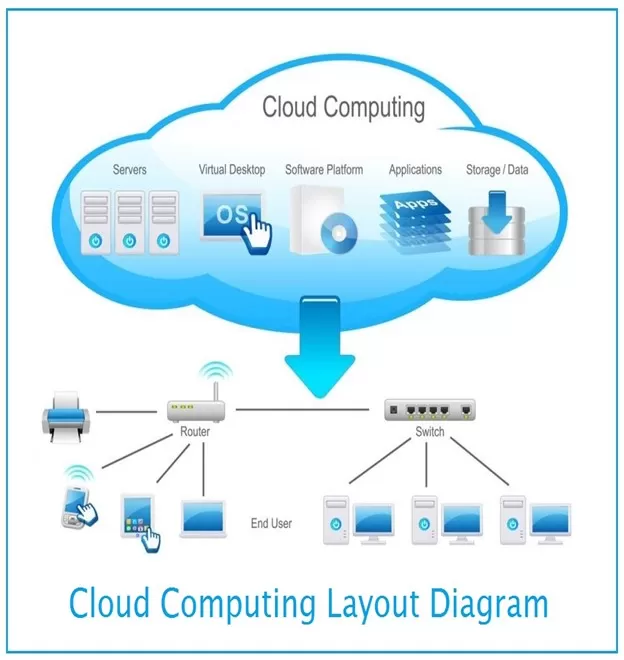Cloud computing is evolving faster than we ever imagined. Every day, new features and capabilities are released that change how we think about, use, and manage cloud services. There is no doubt that the cloud has disrupted the traditional IT landscape, and the momentum of cloud computing shows no signs of slowing down.
But what exactly is the cloud? And why should we use it?
Simply put, the cloud is the Internet – more specifically, it’s all the things you can access remotely over the Internet. When something is in the cloud, it means it’s stored on Internet servers instead of your computer’s hard drive.
Understanding Cloud Computing: Advantages and Importance
Embracing Cloud Computing: A Game-Changer for Businesses
For example, if you’ve ever used a web-based email service, such as Gmail or Yahoo! Mail, you’ve already used the cloud. All the emails in a web-based service are stored on servers rather than on your computer’s hard drive. This means you can access your email from any computer with an Internet connection. It also means you’ll be able to recover your emails if something happens to your computer.

The Advantages of Cloud Computing for Data Loss Prevention and Scalability
Cloud Using the cloud has many benefits, such as:
- Data Loss Prevention: You don’t have to worry about losing your data if your device gets damaged, stolen, or hacked. Your data is always backed up and protected in the cloud.
- Scalability and Flexibility: You can easily adjust your cloud resources according to your needs. You can scale up or down your storage, processing power, or bandwidth without having to invest in expensive hardware or software.
- Cost Savings: You only pay for what you use. You don’t have to buy or maintain any physical infrastructure or licenses. Plus, you also save on energy and cooling costs.
- File Sharing: You can collaborate with others more easily by sharing files and documents in the cloud. You can also access your files from any device, anywhere, anytime.
- Advanced Security Features: Cloud providers offer various security features to safeguard your data from unauthorized access, such as encryption, firewalls, multi-factor authentication, and more.
So how is cloud computing going to change in the next few years?
These days, our heads are all in the cloud. Unless you’re a billionaire, it’s unlikely that you have the resources to pay for a private driver who waits for you and/or brings you food. For us, the non-billionaire folk, we turn to interfaces like Uber and DoorDash to get driving or delivery services on demand. Not only is it more affordable, but it’s also just more practical and available exactly (and only) when you need it.
Cost Savings and File Sharing: Leveraging the Cloud for Business Success
Computing power is much the same. Do you really need it all the time? Sure, huge corporations like banks and financial services firms do – and they may even have their own servers – but most businesses don’t need that kind of power all the time. For them, it’s better if they can pay for only what they need and when they need it.
Trends Affecting the Future of Cloud Computing
Emerging Trends Shaping the Future of Cloud Computing
The future of cloud computing will likely be shaped by several emerging trends that offer new possibilities. Let us explore some of these trends and how they affect cloud computing.
Hybrid and Multi-Cloud Solutions: Finding the Right Balance
– Multi cloud is when an organization uses cloud computing services from more than one cloud service providers, it can be two or more public clouds or private clouds or a combination of them. It is likely to be a mix of hybrid and multi-cloud deployments as businesses seek to find the right balance of agility, flexibility, security, and control.
Edge Computing: Empowering Real-Time Data Processing
– This is the process of processing data closer to where it is generated, rather than sending it to a centralized cloud server. This enables faster and more efficient data processing, leading to better outcomes in real time. Edge computing can complement cloud computing by addressing some of the challenges posed by latency, bandwidth, and security.
- Artificial Intelligence: AI can enhance cloud performance and efficiency by automating tasks, optimizing resources, and providing insights. AI can also accelerate digital transformation in businesses by enabling new capabilities, such as natural language processing, computer vision, and machine learning. AI in the cloud can help businesses become more efficient, strategic, and data-driven, while also reducing costs and increasing flexibility.
Serverless Computing: Simplifying Deployments and Reducing Costs
– Serverless computing is a model that allows developers to build and run applications and services without managing servers. The cloud service provider handles the server management, scaling, and provisioning, while the developer only pays for the resources used when the code is executed. Serverless computing can simplify deployments and lower the operational costs of running cloud-based applications.
Quantum Computing: The Revolutionary Potential of Quantum Physics
– Quantum computing is a paradigm that uses quantum physics to perform computations that are impossible or impractical for classical computers. Quantum computers can store and process data in qubits, which can exist in superposition of two states, allowing for parallel processing and exponential speedup. Quantum computing also reduces the additional cost of creating new resources to handle pre-optimized tasks. Quantum computing can revolutionize businesses in ways we can’t yet imagine.
Secure Access Service Edge (SASE): Integrating Network and Security Functions
– Secure Access Service Edge (SASE) is a cloud-based IT security framework that integrates network and security functions into a single service. SASE adapts to the dynamic nature of work processes, such as remote work, mobile devices, and cloud applications. SASE can provide cloud-based network security services, such as security gateways, firewalls, and zero-trust network access.
Economic Advantages of Cloud Computing: Virtualization and Data Analysis
– Cloud computing can reduce the reliance on hardware by enabling virtualization and sharing of software resources. This can save the setup cost of software and decrease the hardware maintenance cost. Cloud computing can also enable data analysis with machine learning algorithms without requiring human intervention. This can improve the quality and efficiency of data-driven decision making.
As we can see, cloud computing is a game-changer for businesses of all shapes and sizes. It offers a range of benefits, such as scalability, flexibility, security, and cost-efficiency. Cloud computing is not a passing trend, but a lasting revolution that will shape the future of technology and innovation. Whether you are a cloud provider or a cloud user, you can leverage the power of cloud computing to achieve your business goals and stay ahead of the competition.
Cloud Computing: A Lasting Revolution for Technology and Innovation
The Enduring Impact of Cloud Computing on Businesses
Leveraging the Power of Cloud Computing for Business Goals
Staying Ahead of the Competition with Cloud Computing
Conclusion
Embrace the Future: Seize the Opportunities of Cloud Computing.
Thank you for reading!


